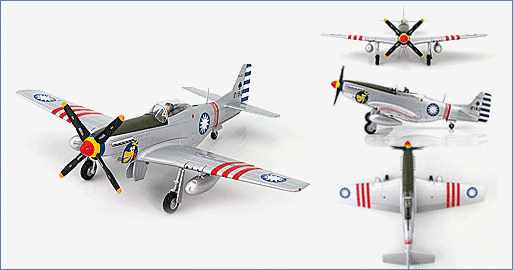Air Power Series>1:48 die-cast display model>P-51>HA7731
P-51D Mustang P-14275, 21st Sqn., 4th FG, ROCAF, c. 1949

General Background
Later in WWII the Allied bombers were flying deep into Germany but suffered tremendous losses because of the lack of range the fighter escorts had. German fighters would wait beyond the range of the Allied fighters and then attack the vulnerable bombers. Once the P-51 called Mustang by the British had the Allison engine replaced with a British Merlin it possessed the high performance that had been lacking. With drop tanks the P-51 had the range to escort bombers all the way to Berlin and back.
The Aircraft
Late in the Sino-Japanese War the U.S. equipped three squadrons of the Chinese Nationalist Air
Force with North American P-51 Mustangs. After WWII the P-51 was used in the fight between
the Nationalists and the Communists forces. By 1949 the Nationalists were losing the war and
retreated to what then was the island of Formosa, now Taiwan. Pilots loyal to the Nationalists
flew their aircraft to the island but 39 P-51s were left behind and became the property of the
Communist PLAAF (People's Liberation Air Force).
Specifications :
Tasks: |
Dive-bomber, bomber-escort, ground-attack, interceptor, photo recon |
| Number Produced All Variants: | 14,819 |
| Dimensions | |
| Height: | 13 ft 8 in (4.16 m) |
| Wingspan: | 37 ft (11.27 m) |
| Length: | 32 ft 3 in (9.82 m) |
| Weight | |
| Empty: | 7,125 lb (3,232 kg) |
| Gross: | 10,100 lb (4,581 kg) |
| Maximum Take-off: | 11,600 lb (5,262 kg) |
| Performance | |
| Engine: | Packard Merlin two-staged supercharged V-1650-7, 12 cylinder V engine 1,695 hp. |
| Maximum Speed: | 437 mph (703 km/h) |
| Ceiling: | 41,900 ft (12,771 m) |
| Range: | 950 miles (1,529 km) |
| Maximum Range: | 2,300 miles (3,701 km) |
| Armament | (6) .50 caliber MG |
| Maximum External Bomb Load – 2,000 lb (907 kg) | |
| Or (4) .5 inch rockets |

